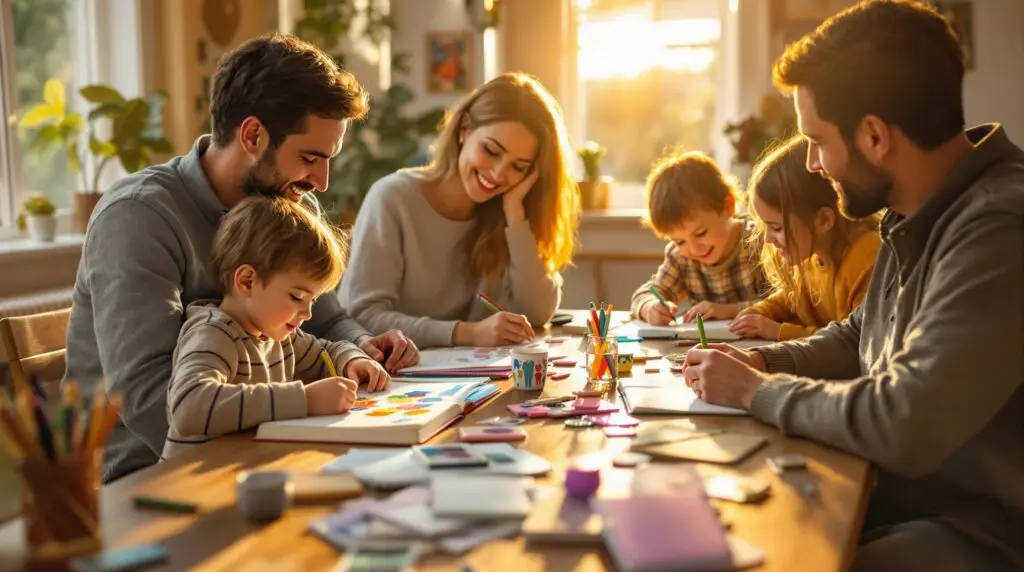Research published in the Journal of School Psychology shows that children who practice gratitude journaling demonstrate significant improvements in academic engagement and social relationships within just eight weeks. Teaching kids gratitude journaling through age-appropriate activities creates a foundation for emotional intelligence and resilience that extends far beyond childhood.
Key Takeaways
- Start gratitude journaling with visual activities for ages 3-6, progressing to written exercises as children develop
- Use specific prompts tailored to each age group to maintain engagement and developmental appropriateness
- Incorporate family participation to model gratitude behaviors and create shared experiences
- Focus on consistency over perfection with short, regular sessions that fit into daily routines
- Celebrate small victories and progress to build intrinsic motivation for lifelong gratitude practice
Understanding Child Development and Gratitude
Children’s brains develop gratitude capacity at different stages. Developmental psychology research shows that kids begin recognizing positive experiences around age 4, but don’t fully grasp the concept of appreciation until age 6-7.
Preschoolers (ages 3-5) respond best to sensory-based gratitude activities. They can identify what makes them happy but struggle with abstract concepts like being thankful “for” something specific.
Elementary school children (ages 6-11) start connecting actions to outcomes. They understand that someone did something nice for them and can express appreciation for specific events or people.
Middle school students (ages 12-14) develop more complex emotional understanding. They can recognize gratitude for intangible concepts like opportunities, personal growth, or future possibilities.
Age-Appropriate Gratitude Journaling Activities
Ages 3-6: Visual and Sensory Gratitude Journaling
Young children express gratitude through drawings, stickers, and simple dictated words. Create a “happiness book” where they draw pictures of things that make them smile each day.
Use a gratitude jar with colorful paper strips. Help them dictate short phrases like “playing with dog” or “mommy’s hugs” while you write. They can decorate the jar and add their own simple drawings.
Photo gratitude journals work exceptionally well for this age group. Take pictures of their favorite moments throughout the day and let them paste photos into a special album.
Ages 7-9: Beginning Written Gratitude Journaling
Second and third graders can write simple sentences about daily positive experiences. Start with grade-appropriate prompts like “Today I felt happy when…” or “Someone was kind to me by…”
Three-good-things journals help children identify specific positive moments. Each evening, they write three things that went well and why they think each good thing happened.
Weather gratitude connects appreciation to daily observations. Children note the weather and find something positive about it, building awareness of finding good in any situation.
Ages 10-12: Detailed Gratitude Journaling
Fourth and fifth graders can handle more complex gratitude concepts. They can write longer entries and explore deeper meanings behind their grateful feelings.
Gratitude letters become powerful tools at this age. Children write thank-you notes to people who’ve helped them, then decide whether to deliver the letters or keep them private.
Advanced prompts help older elementary students think critically about gratitude. Questions like “What challenge helped you grow?” or “How did a difficult situation teach you something valuable?” expand their perspective.
Ages 13-15: Advanced Gratitude Journaling
Teenagers can explore gratitude for abstract concepts like personal growth, opportunities, or life lessons. They’re capable of recognizing how challenges contribute to their development.
Gratitude interviews let teens ask family members or friends about meaningful experiences. They record these conversations and reflect on how others’ gratitude perspectives influence their own thinking.
Future-focused gratitude helps adolescents appreciate current opportunities. They write about how today’s experiences might benefit their future selves or contribute to their goals.
Creating Family Gratitude Journaling Traditions
Family gratitude practices strengthen bonds while teaching children through observation and participation. Parents who model gratitude behavior create the strongest foundation for children’s own gratitude development.
Weekly gratitude circles bring families together for sharing and reflection. Each member shares something they appreciated about the week, creating a safe space for emotional expression.
Gratitude cooking combines appreciation with practical life skills. Families can express gratitude for food while preparing meals together, discussing where ingredients come from and who helped bring them to the table.
Holiday gratitude traditions extend beyond typical thanksgiving practices. Families can create gratitude advent calendars, birthday gratitude celebrations, or back-to-school appreciation rituals.
Overcoming Common Challenges in Teaching Gratitude Journaling
Resistance to Writing
Children often resist gratitude journaling when it feels forced or overwhelming. Start with tiny commitments—just one sentence or one drawing per day builds the habit without creating pressure.
Make gratitude journaling feel special rather than mandatory. Let children choose their own journals, writing tools, or special places to complete their gratitude practice.
Alternative formats reduce writing barriers. Voice recordings, digital photos, or even dance and movement can express gratitude for children who struggle with traditional writing.
Maintaining Consistency
Link gratitude journaling to existing routines rather than creating separate time slots. Bedtime, car rides, or meal preparation offer natural opportunities for gratitude reflection.
Track progress visually with sticker charts or calendars. Children respond well to seeing their consistency efforts rewarded with immediate visual feedback.
Allow flexibility in timing and format. Some days might be three-sentence entries, other days might be quick drawings. Consistency matters more than perfection.
Building Intrinsic Motivation for Lifelong Gratitude
Children develop lasting gratitude habits when they experience internal satisfaction rather than external rewards. Focus on how gratitude journaling makes them feel rather than praise for completing the activity.
Varied prompts prevent boredom and maintain engagement. Rotate between different types of gratitude exploration to keep the practice fresh and interesting.
Connect gratitude journaling to children’s existing interests and values. Sports-loving kids might appreciate teammates and coaches, while artistic children might focus on creative inspiration and materials.
Celebrate growth and awareness rather than perfect entries. When children notice more positive aspects of their daily experiences, acknowledge this increased awareness as the real success.
Measuring Progress and Long-Term Impact
Track your child’s gratitude development through behavioral observations rather than journal content evaluation. Notice increased appreciation expressions, improved mood during difficult situations, or enhanced empathy toward others.
Research from the University of Miami demonstrates that children who maintain gratitude practices show improved sleep quality, increased optimism, and stronger social connections over time.
Monthly reflection sessions help children recognize their own growth. Ask them to flip through previous journal entries and notice patterns in what they appreciate or how their gratitude focus has evolved.
Document your family’s gratitude journey through photos, videos, or family gratitude journals. These records become treasured memories while showing children how their gratitude practice has developed over time.
Supporting Different Learning Styles
Visual learners benefit from gratitude journaling with colors, drawings, and graphic organizers. Create gratitude mind maps, use different colored pens for different types of appreciation, or include photographs and stickers.
Auditory learners thrive with spoken gratitude practices. Record gratitude voice messages, create gratitude songs, or engage in family discussions about daily appreciation.
Kinesthetic learners need movement and touch in their gratitude practice. Gratitude walks, building gratitude sculptures with natural materials, or acting out grateful scenarios engage their learning style.
Social learners prefer group gratitude activities. Gratitude sharing circles, collaborative family gratitude projects, or peer gratitude exchanges meet their need for interpersonal connection.
Addressing Special Circumstances
Children experiencing difficult life transitions need adapted gratitude approaches. Focus on small, immediate comforts rather than big-picture appreciation during times of stress or change.
Anxious children benefit from structured gratitude formats. Provide specific prompts, templates, or guided questions that reduce the overwhelm of open-ended gratitude reflection.
Children with learning differences may need alternative expression methods. Drawing, verbal sharing, or technology-assisted gratitude journaling can accommodate various learning needs while maintaining the core practice.
FAQ
What age should children start gratitude journaling?
Children can begin gratitude activities as early as age 3 with visual methods like drawings and photos. Written gratitude journaling typically starts around age 6-7 when basic writing skills develop.
How long should daily gratitude journaling sessions last?
Keep sessions short—5-10 minutes for young children, 10-15 minutes for older kids. Consistency matters more than duration, so brief daily practices work better than long weekly sessions.
What if my child resists gratitude journaling activities?
Start with their interests and make it fun rather than mandatory. Try different formats like voice recordings, photos, or gratitude games. Model gratitude yourself and avoid forcing the practice.
How can I help my child find things to be grateful for?
Point out positive moments throughout the day, ask specific questions about their experiences, and help them notice small details like favorite foods, comfortable clothes, or fun activities.
Should gratitude journaling replace other emotional development activities?
No, gratitude journaling complements other emotional skills. Continue teaching empathy, problem-solving, and emotional regulation alongside gratitude practice for well-rounded development.
Sources:
Greater Good Science Center
American Psychological Association
National Center for Biotechnology Information
Taylor & Francis Online
Wiley Online Library
ScienceDirect
Springer
National Association of Elementary School Principals
Random Acts of Kindness Foundation
Sleep Foundation





